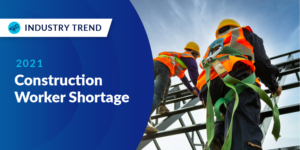
Contractors nationwide are struggling with growth during the pandemic — this isn’t original news. However, contractors are really having a tough time with growth in labor well into 2021, and this is having a major impact on new work.
“Construction employment remains below pre-pandemic levels in more than two-thirds of the states,” said Ken Simonson, chief economist of the Associated General Contractors of America (AGC). “Supply problems have slowed down many projects and forced contractors to hold down employment, while the lack of an infrastructure bill is leading some to delay hiring.”
These issues are having a significant impact on businesses, and not just in an existential way.
“Just about anybody you talk to anymore is in the same boat. It’s really, really become an issue,” said Kevin Hubbell, a project manager for York’s Royal Square Development and Construction. “In fact, I was talking to a contractor just yesterday, and they’re on the verge of just closing up their doors. They’re just run ragged, pretty much.”
“Most contractors don’t have ‘no’ in their vocabulary,” added Brian Turmail, vice president of public affairs and strategic initiatives for AGC. The association is saying that contractors are having to shift the way that employees are having to work, much to their own detriment. “They’ll work 80 hours a week if they have to, but there’s no amount of hours that will solve the supply challenges.”
There’s a challenge in the pipeline regarding different skills needed in labor, too. “The more skills required, the harder it is to fill,” Turmail noted. “The equipment operators, carpenters, bricklayers, HVAC folks, anyone where they’ve gotta learn more than just basic construction to be successful is in tight supply.”
Major areas around the country are being impacted, too. According to AGC, nearly a fifth of metro areas in the USA lost construction jobs between September 2020 and September 2021. “Many metro areas are having a hard time getting back to construction employment levels from last fall that were already low because of the pandemic,” said Ken Simonson. “The challenge is that the economic recovery for the construction industry is being undermined by Washington’s failure to boost infrastructure investments and continuing supply chain dysfunction.”
Many contractors are taking this time to analyze how they’re interacting with their employment pool, and looking to change their talent pipeline in order to shift who they’re getting to.
“You can see patterns from where you got your best people from. We’re often blind to that. We’re making assumptions,” said Jason Tsyzko, vice president for the U.S. Chamber of Commerce Foundation’s Center for Education and Workforce. “There’s a lot of workforce pains for companies, so everybody’s trying to access talent and keep talent.”
Organizations nationwide are hoping to fix this by working to recruit, and it’s not just the responsibility of individual contractors. A recent event in Rochester, Minnesota focused on a desire on the part of the local government itself to recruit women and minorities into the construction industry in a move emblematic of focuses around the country.
“We’re really engaging the construction industry,” noted City of Rochester Project Manager Jorrie Johnson. “We really want to know from contractors and union representatives what we can do to get people ready to work in the trades.”
The advice from Brian Turmail? “Encourage people to get back into the labor market because we know that’s the best place for people to be.”
Contractors are keeping their options open and keeping active in this goal. “Hope is not a strategy,” Tsyzko added. “There’s no easy answer.”
“Most contractors don’t have ‘no’ in their vocabulary. They’ll work 80 hours a week if they have to, but there’s no amount of hours that will solve the supply challenges.”
– Brian Turmail, vice president of public affairs and strategic initiatives for AGC
Contractors’ problems are compounding, with industry feeling impacts from supply shortages, lack of federal support
These organizational leaders aren’t looking to the labor shortage as the only issue right now, though, despite the struggles of companies to keep their employment levels up.
“There’s a shortage of metal products. Their prices have gone through the roof,” Brian Turmail said. “That’s almost as big, if not bigger, of a nightmare than the labor issue.”
Dive deeper: Lumber & Steel Material Shortages Cause Confusion, Delays on Large Public Projects
“It’s requiring construction firms to come up with alternative materials, to be more flexible in their schedules, and to manage expectations more than they were before,” he added.
With people looking for a boost nationwide, a large number of contractors are hoping that the infrastructure bill championed by President Biden gets passed soon.
“The latest state employment figures show that gridlock in our ports and on Capitol Hill is retarding construction employment as well as the broader economy,” said Stephen E. Sandherr, chief executive officer for the AGC. “Even as the administration looks for ways to unclog domestic supply chains, the President should urge the House to pass the infrastructure bill, on its own, as quickly as possible.”
Following the publishing of its report that both residential and non-residential construction fell during September 2021, officials with the AGC urged the House of Representatives to complete work on the bipartisan infrastructure bill passed by the Senate earlier in 2021.
“This legislation advances the policy priorities that members of both parties have long said they want,” said Sandherr. “It is disgraceful that both sides are still holding these projects hostage while sorting out other priorities. Construction workers, businesses, and the public deserve better.”